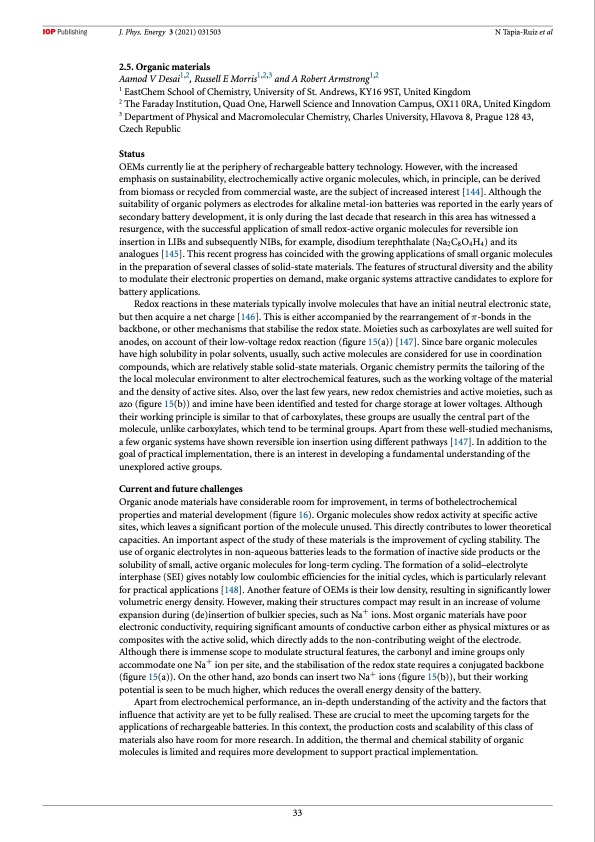
PDF Publication Title:
Text from PDF Page: 034
J. Phys. Energy 3 (2021) 031503 N Tapia-Ruiz et al 2.5. Organic materials Aamod V Desai1,2, Russell E Morris1,2,3 and A Robert Armstrong1,2 1 EastChem School of Chemistry, University of St. Andrews, KY16 9ST, United Kingdom 2 The Faraday Institution, Quad One, Harwell Science and Innovation Campus, OX11 0RA, United Kingdom 3 Department of Physical and Macromolecular Chemistry, Charles University, Hlavova 8, Prague 128 43, Czech Republic Status OEMs currently lie at the periphery of rechargeable battery technology. However, with the increased emphasis on sustainability, electrochemically active organic molecules, which, in principle, can be derived from biomass or recycled from commercial waste, are the subject of increased interest [144]. Although the suitability of organic polymers as electrodes for alkaline metal-ion batteries was reported in the early years of secondary battery development, it is only during the last decade that research in this area has witnessed a resurgence, with the successful application of small redox-active organic molecules for reversible ion insertion in LIBs and subsequently NIBs, for example, disodium terephthalate (Na2C8O4H4) and its analogues [145]. This recent progress has coincided with the growing applications of small organic molecules in the preparation of several classes of solid-state materials. The features of structural diversity and the ability to modulate their electronic properties on demand, make organic systems attractive candidates to explore for battery applications. Redox reactions in these materials typically involve molecules that have an initial neutral electronic state, but then acquire a net charge [146]. This is either accompanied by the rearrangement of π-bonds in the backbone, or other mechanisms that stabilise the redox state. Moieties such as carboxylates are well suited for anodes, on account of their low-voltage redox reaction (figure 15(a)) [147]. Since bare organic molecules have high solubility in polar solvents, usually, such active molecules are considered for use in coordination compounds, which are relatively stable solid-state materials. Organic chemistry permits the tailoring of the the local molecular environment to alter electrochemical features, such as the working voltage of the material and the density of active sites. Also, over the last few years, new redox chemistries and active moieties, such as azo (figure 15(b)) and imine have been identified and tested for charge storage at lower voltages. Although their working principle is similar to that of carboxylates, these groups are usually the central part of the molecule, unlike carboxylates, which tend to be terminal groups. Apart from these well-studied mechanisms, a few organic systems have shown reversible ion insertion using different pathways [147]. In addition to the goal of practical implementation, there is an interest in developing a fundamental understanding of the unexplored active groups. Current and future challenges Organic anode materials have considerable room for improvement, in terms of bothelectrochemical properties and material development (figure 16). Organic molecules show redox activity at specific active sites, which leaves a significant portion of the molecule unused. This directly contributes to lower theoretical capacities. An important aspect of the study of these materials is the improvement of cycling stability. The use of organic electrolytes in non-aqueous batteries leads to the formation of inactive side products or the solubility of small, active organic molecules for long-term cycling. The formation of a solid–electrolyte interphase (SEI) gives notably low coulombic efficiencies for the initial cycles, which is particularly relevant for practical applications [148]. Another feature of OEMs is their low density, resulting in significantly lower volumetric energy density. However, making their structures compact may result in an increase of volume expansion during (de)insertion of bulkier species, such as Na+ ions. Most organic materials have poor electronic conductivity, requiring significant amounts of conductive carbon either as physical mixtures or as composites with the active solid, which directly adds to the non-contributing weight of the electrode. Although there is immense scope to modulate structural features, the carbonyl and imine groups only accommodate one Na+ ion per site, and the stabilisation of the redox state requires a conjugated backbone (figure 15(a)). On the other hand, azo bonds can insert two Na+ ions (figure 15(b)), but their working potential is seen to be much higher, which reduces the overall energy density of the battery. Apart from electrochemical performance, an in-depth understanding of the activity and the factors that influence that activity are yet to be fully realised. These are crucial to meet the upcoming targets for the applications of rechargeable batteries. In this context, the production costs and scalability of this class of materials also have room for more research. In addition, the thermal and chemical stability of organic molecules is limited and requires more development to support practical implementation. 33PDF Image | 2021 roadmap for sodium-ion batteries

PDF Search Title:
2021 roadmap for sodium-ion batteriesOriginal File Name Searched:
roadmap-sodium-ion-batteries_031503.pdfDIY PDF Search: Google It | Yahoo | Bing
Salgenx Redox Flow Battery Technology: Salt water flow battery technology with low cost and great energy density that can be used for power storage and thermal storage. Let us de-risk your production using our license. Our aqueous flow battery is less cost than Tesla Megapack and available faster. Redox flow battery. No membrane needed like with Vanadium, or Bromine. Salgenx flow battery
| CONTACT TEL: 608-238-6001 Email: greg@salgenx.com | RSS | AMP |